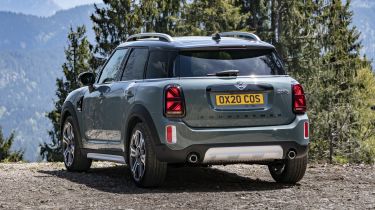MINI Countryman SUV (2016–2023) - MPG, running costs & CO2
Economical engines mean running a MINI Countryman shouldn’t cost the earth
Running costs have always been a MINI strong suit, and actually getting a MINI Countryman on your driveway can be temptingly affordable. Compact SUVs have never been more popular and the fact the Countryman is a sought-after secondhand buy, with high resale values, means monthly finance costs can actually be lower. Just don’t expect too many deals or deposit contributions to be available.
MINI Countryman MPG & CO2
The economy headlines all belong to the Countryman Plug-In Hybrid. MINI claims it can run for up to 31 miles on electric power alone and also that 90% of its buyers drive no more than 30 to 40 miles a day. If this is true, the Countryman hybrid seems a perfect fit. Private buyers might baulk at its expense to buy outright but company-car users will see the appeal of its low 41-44g/km CO2 emissions – placing it in a much lower Benefit-in-Kind (BiK) tax banding for company-car drivers. Choosing the plug-in hybrid will slash your tax costs by at least half.
Its fuel economy of 156.9mpg will be of more interest to private buyers, though, and a day-to-day electric driving range of 15-18 miles is more likely. There’s clever technology to help you eke that range out as far as possible using sat-nav information, it can work out which portions of your pre-programmed route are best suited to all-electric power and it knows to preserve battery power until you reach a built-up area.
More reviews
The entry-level 1.5-litre 134bhp petrol engine can return up to a respectable 44.1mpg and will be a sensible choice for those who make frequent short journeys. The Cooper S, with its turbocharged 2.0-litre petrol engine, can manage up to 43.5mpg (or 39.8mpg in All4 four-wheel drive guise). Driven carefully, the most powerful John Cooper Works version achieves up to 37.2mpg; rivals such as the Volkswagen T-Roc R and Audi SQ2 don’t officially crack 35mpg. No diesel engines are available in the Countryman range any more.
After the first year’s CO2-based tax (typically included in the on-the-road price), petrol MINI Countryman models cost the standard VED (road tax) rate each year, while the hybrid qualifies for the discounted rate. Those with a list price (including options) of more than £40,000 are liable for the additional surcharge in years two to six, taking your annual tax bill to more than £500 in that time.
Insurance
Insurance groups range from group 18 for the Countryman Cooper Classic to group 26 for the plug-in hybrid Exclusive trim. The John Cooper Works Countryman will be the most expensive to insure and occupies insurance group 33.
Servicing
Servicing your MINI follows a condition-based regime, with the frequency and nature of workshop visits being determined by sensors around the car that measure things like oil purity. The first oil change is likely to be indicated as due at around 12,500 miles, with subsequent changes every 18,000 miles after that. MINI offers TLC service packages to meet the needs of most motorists, containing the service costs for your first three years or 36,000 miles of ownership.
Wear-and-tear items like brake pads are automatically monitored, while the on-board computer will let you know when the car is due an inspection, based on time elapsed and by monitoring the way your car is driven.
Warranty
All UK MINIs are covered by a three-year/unlimited-mileage warranty, which has become pretty much the European industry standard. It’s not a bad warranty package, but does look less than generous in the light of those offered by South Korean carmakers – Hyundai offers a five-year/unlimited-mileage policy while a new Kia is supplied with cover for seven years or 100,000 miles. You can, though, pay for your warranty to be extended by your MINI dealership after the policy provided with the car has expired.













